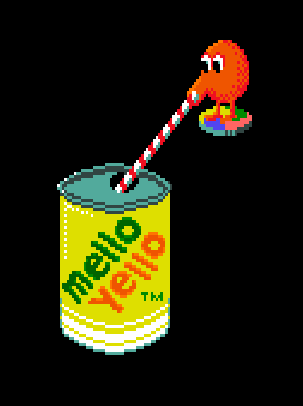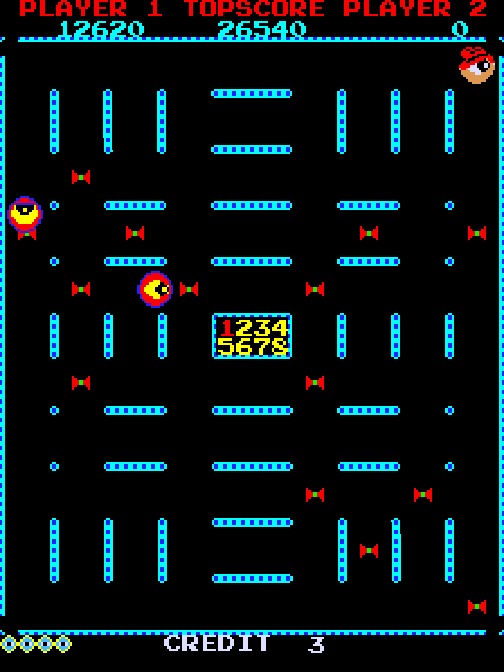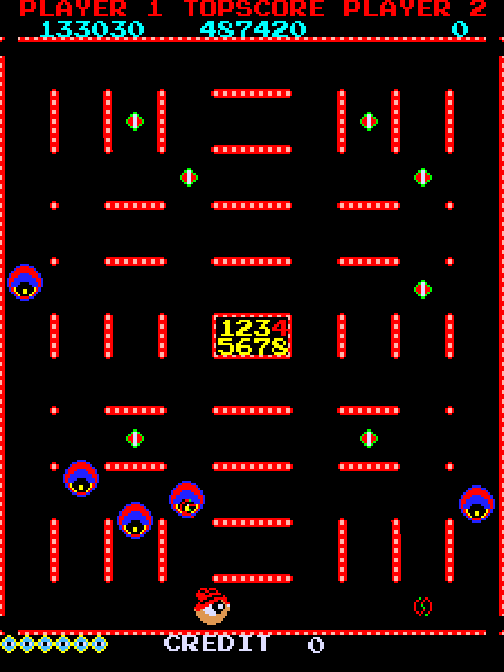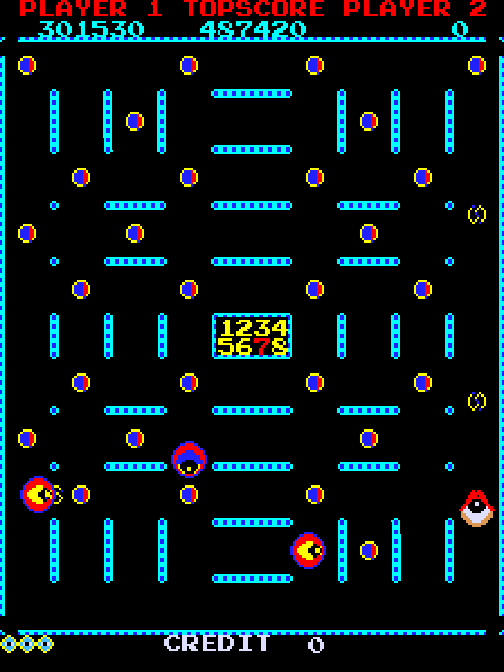Of all the licensed games I’ve done up to this point, Moonwalker is by far the longest of long-shots for a modern re-release. Sega can’t even get the estate of Micheal Jackson to come to the table over Sonic The Hedgehog 3’s soundtrack. I thought maybe there was residual postmortem bad blood, since Jackson apparently wasn’t happy with how his arrangements for Sonic 3 sounded on the Genesis. But, that obviously isn’t the hold-up. Jackson later voiced himself in the Space Channel 5 franchise, so clearly no bridges were burned. The real question is “how much could his estate possibly want for chiptunes?” It’s not like this is a previously unreleased Beatles track we’re talking about. It’s a series of harmonious bloops and bleeps that sound sort of like his famous songs. If anything, people hearing them might be inclined to spend money on the real songs. The “arrangements” featured in the video games have zero value to the estate. Again, we’re talking about bloops and bleeps here.

Let me address the planet-sized elephant in the room. No, not that one. NO, not that one either. I’m talking about the lack of Thriller. Even deep into the production of Moonwalker, the designers were under the impression they could use the iconic song and created levels tailored to it. However, they were later informed that only songs personally written by Jackson himself were available. And thus, all three games have graveyard scenes without what is arguably the most popular Michael Jackson song backing the action. It is SO unavoidably awkward, especially since the fully-charged magic dance attack in the graveyard level clearly has the dance moves from Thriller. I don’t listen to Jackson’s songs and even I think this is lame as f*ck.
Good bloops and bleeps, mind you. My mother, a fan of Jackson’s work, could identify what each song was supposed to be in the arcade and Genesis versions. But, that also means they’re good enough to assure Moonwalker will likely never see the light of day again. The closest we came to a re-release was in 2011, when Sega submitted a version of Moonwalker for PEGI rating on the Wii’s Virtual Console, but nothing came of it (it’s unclear which version, but I’m guessing the Genesis one). Presumably it was done by mistake. It happens. No matter what you think of Michael Jackson, this much is clear: he loved video games and was proud of his work with Sega. It’s not like the games paint him in a bad light, and it’s also not like someone would buy this in lieu of a CD. Nobody on this planet is going to say “well, I was going to buy a collection of Michael Jackson songs, but I bought this video game that has electronic beeps arranged in a way that sounds kind of like his songs, so I’m covered!” Can we please do the right thing here and come to the table like grown-ups? Because these games are worth a look today, in 2023. Especially the arcade version. On with the reviews!
 Michael Jackson’s Moonwalker
Michael Jackson’s Moonwalker
Platform: Arcade – Sega System 18
Developed by Sega and Triumph
First Released July 20, 1990
NEVER BEEN RE-RELEASED

This should be a joke. A borderline parody. But, it’s actually a very good game.
I played the arcade version of Moonwalker after playing the two console versions, but chronologically, this was released first. And now, I’m wondering if the more bland and basic Genesis/Master System versions soiled the reputation of the coin-op. Seriously, why does Moonwalker never come up in conversations about the best licensed arcaders? THIS IS GREAT! I don’t even normally like isometric games. In fact, I kind of hate them. I always get discombobulated trying to walk in a straight line when I play them, and that’s not even the most annoying aspect of the game. Moonwalker features this strange pseudo-auto-scrolling gameplay that makes it feel like you’re getting the bum’s rush through the set-pieces. But, actually, it’s about thirty to forty minutes of perfectly-paced non-stop action.

I have no clue why, but the first level of the game lasts roughly one minute and consists of a single street corner. It’s not as if the game is so complex it requires a tutorial stage, but that’s sort of what it feels like.
It’s probably best to think of Moonwalker as a close cousin to Altered Beast. The same type of slow-scrolling, hoard-smacking fisticuffs, only played from a different angle, with only one button for all striking moves. Gosh, that actually sounds like my idea of the fourth circle of hell. So, you can imagine my surprise that the smile never vanished from my face during my first session with Moonwalker. Part of that is that the enemies aren’t completely brainless. There’s a fairly nice variety of them to smash, and you’re always given enough room to dodge out of the way of their shockingly elegant attack formations. You can also charge-up your attack, though this was the one weakness of the game’s combat. It’s too hard to aim the charged up shots if you move around before unleashing them. In general, you’ll spend most of the time blasting enemies with energy directly with your hand. Most baddies only take two hits to kill, and the levels go by quickly. One or two of the robots were a bit spongy, but not in a deal breaker sort of way.

If you’re turning around while you attack, you do this little spin-attack. So the one-button aspect of the combat is deceptive, because there’s a little hint of nuance to it.
I know what you’re thinking. “Where the heck is she getting an Altered Beast comparison out of that?” It’s because you transform near the end of each stage. For you children of the 2000s, Michael Jackson famously had a chimpanzee named Bubbles that he took everywhere he went. Bubbles shows up where you’re next to the boss for each area. Touching him transforms you into MECHA JACKSON! (imagine a Godzilla roar here for full effect). At this point, you get projectiles and your charge-shot becomes a pair of missiles. This is where the run ‘n gun gameplay takes over, though the “run” part is misleading, since you still move around the screen at the same pace, and usually there’s not too many basic enemies to wax before you encounter the boss. As much as I enjoyed the shooting combat, the bosses are the game’s weak link. They’re generic robotic contraptions that feel like they belong to another game. Not boring to fight, mind you. But they often feel out of place with the set pieces.
This slideshow requires JavaScript.
The most memorable aspect of Moonwalker are the bombs. You get one per life and some of the children you rescue will grant you additional ones. When you activate them, all the enemies on the screen join you in a dance number. Even the robotic enemies (including the robotic dogs) do it, and when the dance ends, they all die. While it’s disappointing that you’ll briefly turn back into the human MJ when you activate a bomb as Mecha Jackson, it’s SO SATISFYING to use the dance move. It gives the whole game a music video vibe, and it does a better job of it than the more choreographed Genesis Moonwalker. In the arcade game, I found myself timing it when enemies were standing on the perfect spot to make it look like a performance. I wanted to do it that way. It made the experience more fun.
This slideshow requires JavaScript.
Okay, so Moonwalker isn’t the deepest game. But, it is the ideal early 90s arcade experience. A simple action concept with easy-to-understand combat that’s polished to a mirror shine. From a gameplay perspective, the only real “hole” is that the enemy themes don’t always feel like they belong. When your main gameplay issues are slight thematic inconsistencies, you probably have a very good title. You couldn’t make a game like Moonwalker today. It’s too simple. Too short. Too limited. People wouldn’t stand for it. Yet, it’s telling that I, a total non-fan of Michael Jackson, could walk away as satisfied as I ever have been by a game of this type. Even without the novelty of Michael Jackson being the star, Moonwalker is worth the forty-five minutes max it takes to play-through. A perfect example of how to do a licensed arcade game, and especially a game that is really a vehicle for one specific celebrity. I honestly can’t imagine any game could do better at that, really.
Verdict: YES!
 Michael Jackson’s Moonwalker
Michael Jackson’s Moonwalker
Platform: Sega Genesis
Developed by Sega
First Released August 24, 1990
NEVER BEEN RE-RELEASED

And you thought the stairs in Castlevania games were frustrating. Holy crap, it’s INSANE how hard it is to just begin the process of walking up a flight of stairs in this game.
Going a completely different direction, the Genesis version of Moonwalker uses a heavily modified version of the engine that powered Genesis launch-window title Revenge of Shinobi. Whereas rescuing children is a side task in the coin-op, this time around, finding hidden children is the entire object. You play fifteen stages of opening every door, window, car trunk, etc, until you find X amount of kids. At this point, all enemies completely vanish and Bubbles the Chimp appears and points you in the direction of the “boss” encounter. It makes the Genesis take on Moonwalker a much slower experience, and one that’s absurdly repetitive.
This slideshow requires JavaScript.
I know this is the oddest observation possible about Moonwalker, but the first thing that stuck out to me is the movement of the sprites. The tall, slender characters move around with this spooky fluidity to their locomotion. It’s both unnervingly unnatural and oddly hypnotic. It also looks remarkably like prime-era Michael Jackson’s dancing, which I guess is the point. It’s just a shame the actual combat doesn’t feel more dance-like. While the Genesis game retains the blue “energy” that Michael Jackson emits when he throws punches and kicks, this time around, there’s no OOMPH to it. His standard ground-based attack is the weakest-feeling kick this side of Taito’s Superman coin-op. Part of the lack of weight and gravity comes from the fact that the kick has incredible range, at least if you have enough health to give Michael his magic powers. The more health you have, the more range the fairy dust or whatever it is he sprays from his limbs reaches. In practice, it looks exactly like he stepped in a puddle and is kicking the water off his shoes. WELL, THAT’S WHAT IT LOOKS LIKE!

Actually, it looks more like snowflakes, and it spreads out, too. You can barely see it in this picture, but the fairy dust I kicked out is about to kill this dog. It’s quite a ways from me, too, so it’s pretty powerful.
There’s more than just kicking and punching, but it comes at a cost. Holding the A button down makes Michael spin, which causes damage to anything that touches you, but your health starts to drain. If you hold the spin move for a second or so before letting go, Michael throws his hat, which is an instakill on almost anything it touches. If this had a lot of range, or didn’t cost health, it’d be a fun attack. It has a bit more OOMPH than the fairy dust attacks have. Hell, this should have been the game’s basic attack, but it’s not. It costs health to use, it takes time to activate, AND, unlike the fairy dust, it doesn’t spread out. I never found a single usage for it where I wasn’t better off using the kick. Life is plentiful in Moonwalker. Every kid restores health, so you should always have close to a fully-charged magic kick. The hat is WORTHLESS! Here’s the exact same location from the above picture, only using the hat.

Not only is the hat going right over the damned pooch, but it ate-up health AND takes longer to perform. The guy above me had time to get away while I spun-up the attack. One of gaming’s most worthless moves.
Now, I made a major boo-boo the first time I played Moonwalker. I didn’t know about the all-powerful fully-charged magic attack. It takes literally half a full life bar to unleash and causes all the enemies on the screen to join you in a dance number, just like in the arcade game. My first time playing the Genny Moonwalker, I didn’t want to drain my health and I found the hat-toss to be worthless, so I stayed away from the magic attack. I only discovered the dance-off thanks to my play-through of the Master System game. The magic dance is especially useful for clearing the level “bosses.” They’re usually not bosses in the “big boss” sense, but rather massive waves of basic enemies. When you perform the move correctly and the screen is full enough of bad guys, it does succeed in making Moonwalker feel like a music-based action game. Unlike the arcade game, enemies actually line-up next to Michael to make the dance look more authentic. So, there’s that. Of course, it doesn’t always work, either. For example, the storm troopers in level 2-2 just run away when you begin to dance, and other bosses might be damaged, but not die.
This slideshow requires JavaScript.
Moonwalker’s main objective is also the game’s fatal flaw: finding the children in each stage becomes dull after a while. If there were visual clues or some kind of logical way of sussing-out their location, it would be one thing. OR, alternatively, if their locations were randomly generated. Then I could live with the mechanic. But, besides the near-certainty that the upper corners will be hiding spots for them, it’s really just blind searching the first time around, and it grows old quickly. There’s not a whole lot to break up the monotony. The level design doesn’t really become interesting until you reach a laboratory in the very last game world, where there’s teleporters that make the levels a maze. That’s so much better than the world before that, which features caves that you had to go inside of to rescue the kids. Since the majority of the caves are empty BUT you also have to make your way back to the door, it feels more like additional busy work. Moonwalker already suffers from too much busy work just by having to manually walk to the area of the map you fight the boss in. The Sega Master System version cuts that aspect from the game and is better off for it.

The labs are fun levels. Walking through empty stages while Bubbles points you towards the area of the map that doubles as the boss chamber? Not so much.
I really do think the “hide and go seek” gameplay could work if it was only used for one of the three levels in each world. If they had come up with some kind of other gimmick for the rest of the stages, I think Moonwalker would have been a much better game. Actually, they DID come up with a better gimmick. At the tail of my first play-through, I turned into a robot and had to clear dozens of enemies with laser beams. I thought “why wasn’t there more of THAT in the game?” Especially after I played the arcade game, where each level closes with MECHA MICHAEL. Well, it turns out, there’s actually a way to do that in other stages if you correctly pick the right child to rescue first. There’s no way of knowing without consulting a guide which child. I didn’t even know this was possible until my mother, a huge Michael Jackson fan, discovered it in level 3-3. Picking the completely arbitrary correct child makes a blue star fall from the sky, and you turn into a robot who can shoot lasers and missiles. It sounds delightful, but during the 30 or so seconds it lasts, you can’t perform the search behind graves or bushes for the kids. It brings the actual objective to a screeching halt. That’s NOT what I meant, game!
This slideshow requires JavaScript.
Then, after fifteen levels of side-scrolling, glorified item fetching gameplay, Moonwalker on the Genesis turns into a stripped-down Star Raiders knock-off for about a minute or two where you fight Joe f’n Pesci. HUH? What? And he doesn’t even have a baseball bat? Boooooo! Oh, and this whole sequence is jarring and terrible and should never have closed the game. Couldn’t they have just had one single normal boss fight? The game comes close a few times, especially in the graveyard. There’s a section where two zombies throw their torsos at you, and that was the only point where I actually died fighting a boss. The Star Raiders section provides no sense of closure. It doesn’t “feel” climatic. It’s so lame.
This slideshow requires JavaScript.
I don’t know what to make of Moonwalker. You can tell really quickly that the main reason it exists is to showcase the technical superiority of the Sega Genesis over Nintendo’s NES. And it is impressive for a 1990 game. Especially when the screen fills-up with enemies. Moonwalker just lacks the excitement or structure of a truly great action game. On the other hand, some of the set pieces are fun (especially the graveyard and lab stages) and it’s still a short game, overall. It should take the average gamer today under two hours to finish. What I found to be the most telling thing about Moonwalker is that my non-gamer mother, a huge Michael Jackson fan, preferred the Genesis version to the arcade one. She played through the whole thing and enjoyed it thoroughly (until she got to the spaceship finale, which I had to beat for her). Yep, that says it all: the Genesis game is made to be accessible to everyone, whereas the coin-op is clearly more tailored to what a hardcore gaming fan would enjoy.

Moonwalker’s biggest gameplay issue is the CONSTANT whammies you find in the search for the kids. Being the scoundrel that I am, I used the emulator to bypass a lot of them. Especially in the fourth level, where I’d rewind to avoid entering empty caves. This was probably the game I cheated most playing in 2023. Moonwalker fans, before you clutch your pearls, you might want to wait and see what the end result of that cheating was.
I can’t review from the perspective of my mother. I will say she was blown-away by Moonwalker on the Genesis. She had genuine regret she never played this before I did this review. The question for me is “did I have more fun than not?” The answer is yes, but there’s an asterisk attached to that. I confess that I used cheating to cut out a lot of the bad aspects of Moonwalker. I found it easier to rewind the whammies (or empty caves in the fourth level) than to live with the consequences. Had I not done that, I think I would have given up on Moonwalker during that god awful 4th level. Being able to undo the busy work of manually walking out of the cave saved it for me. So, I’m going to give Moonwalker a YES! because I do believe it’s worth looking at in the 2020s. Not just as a historical curio, either. There’s genuine gameplay merit to had. But, if I didn’t have rewind or save states, I’d likely have scored this a NO! since the emulator itself made the game more fun than it would have been playing on an authentic Genesis cartridge. Make no mistake: Moonwalker was never fated to age well. So, the fact that what’s still here is actually playable and even enjoyable in the 2020s is remarkable.
Verdict: YES!
 Michael Jackson’s Moonwalker
Michael Jackson’s Moonwalker
Platform: Sega Master System
Developed by Arc System Works
Published by Sega
First Released August 24, 1990
NEVER BEEN RE-RELEASED
This slideshow requires JavaScript.
The 8bit Sega Master System Moonwalker was so close to defeating its Genesis big brother that it could taste victory. It features the same “glorified hide-and-go-seek” objective with finding children as the Genesis version and carries over all the set pieces from that game. However, to make up for the hardware limitations, there’s some big changes. Some are very positive. The fairy dust nonsense that took the OOMPH out of the combat? That’s gone. The biggest change is, this time, your kicks and punches have to physically connect to enemies to defeat them. As a fan of video game violence, I appreciated that very much, and Moonwalker SMS was just getting started. The hat throwing? That’s now a power-up you can use for the remainder of a level when you find a Michael Jackson doll while searching for the children. Oh, and it costs no health to use it. Nice. Last but not least: having to manually walk to the area of the map that’s meant to be the boss chamber? That’s thankfully gone. When you rescue the final kid, Joe Pesci taunts you, and you just magically teleport to the boss chamber. These are all positive changes.

Even the laboratory level feels a lot more maze-like. Easily the strongest level in any of the Moonwalker games. That includes the coin-op too. Yes, really! I know, right?
But, the downgrades let the air out of everything. The “boss” fights are limited by the power of the Master System’s hardware. So, at most, only two guys will fight you at any one time. I never had to use the magical dance-off move, since boss battles devolved into me walking left and smacking one guy, then walking right and smacking the next one, then repeating that process until the game told me I’d won the fight. It wasn’t fun to use the dance off move anyway, since the enemies don’t dance with you. Instead, the rest of the screen fades out while you dance all alone. Awful. Moonwalker makes the same mistake so many bad Sega Master System games did: trying to replicate gameplay done on superior hardware, instead of keeping true to the spirit of that gameplay in a way that plays to the system’s strengths, like Castle of Illusion did.

Womp womp.
Even with all those problems, I was so close to going YES! on 8bit Moonwalker. I can’t stress enough how well done the three lab levels were. The best levels in the entire franchise, easily. And then.. it happened. Remember how the Genesis game ends in a bad Star Raiders knock-off? Well, the Master System version ends differently too, but there’s no space battle. Instead, it ends with something that feels like the over-the-shoulder sequences in Contra. You transform into MECHA JACKSON and have to kill roughly four trillion soldiers, give or take. It feels out of place and wrong. I was like “okay, interesting way to end the game that has no connection to the previous fifteen levels of mind-numbing tedium, but whatever.” Honestly, this wasn’t god awful or anything. It just felt like it belonged to another game. BUT HEY, the 16bit version ended in a similar disconnected way, and I said YES! to it, right? Well, 8bit Moonwalker wasn’t done trolling me yet.

This one wasn’t TOO bad.
There is one final “boss” battle, and it might be the worst element of any retro game I’ve done up to this point. It’s yet another Contra-like sequence, only this time you take the form of a spaceship. There’s four cannons that open their hatches and fire at you, and you have to destroy them. That sounds reasonable, right? What if I told you the hatches open for only a split second? And what if I told you the projectiles they shoot lock onto you? Sometimes for the entire length of the screen. I have no idea how anyone could have ever finished this sequence without extreme amounts of cheating, because it took me FOREVER just to find an angle where the cannon lasers would barely miss me. Even when this happened, remember, the hatches only open for a fraction of a second. That meant I had to move off the safe spot I’d barely been able to find in order to cause damage to the cannons, which take multiple hits to kill and fire the most accurate heat-seeking shots in gaming history. This sequence burned through any good will the Sega Master System version of Moonwalker earned.
This slideshow requires JavaScript.
Not that it was AMAZING up to that point. I mean, it was good enough that I felt retroactively happy for children of 1990 who had the Masters System and couldn’t upgrade to the Genesis. It almost pulled off a convincing impression, too. Well, so much for that. It’s such a sloppy, nonsensical way to end the game. It feels completely unrelated to all the action that happened up to this point. I suppose I could say that SMS Moonwalker is worth playing if you quit as soon as you beat the last normal level, but then I remembered how bored I was making my way through the parking garage or the caves. Unlike the Genesis version, this barely held my attention, even with arguably better combat. The biggest problem is there’s just not enough combat. The hardware limitations mean that you usually only fight one person at a time. It’s not enough to be fun. 8bit Moonwalker is a blander version of a game that’s already toying with blandness.
Verdict: IT’S BAD! IT’S BAD! IT KNOWS IT (THAT’S A NO!)
 Willow
Willow





 Q*bert
Q*bert








 Virtual Boy Wario Land
Virtual Boy Wario Land






 The Three Stooges
The Three Stooges















 Eyes
Eyes


 Colored Effects
Colored Effects




 80% of the bosses being lame aside, Colored Effects is a very good puzzler. I really don’t have too many notes on the puzzle logic itself, because movement and the box shoving physics are so accurate that you don’t even stress them. There’s no pixel-perfect jumping required. I can only think of one single level where I felt the timing of activating switches and special moves at the correct moments was so precise that novice gamers might struggle with performing it even if they figure out the solution. No, this is actually nearly perfect as far as this genre goes because the movement/timing is so fine tuned that it really becomes your wits versus the puzzle design, and the controller isn’t a factor at all. And they’re really good puzzles too. You don’t have to be a brain surgeon to enjoy Colored Effects. In many ways, it’s the ideal Nintendo Switch puzzler. The toughest part of Colored Effects for me was writing this review, really. What can I say? It’s hard to write about a game that does so little wrong.
80% of the bosses being lame aside, Colored Effects is a very good puzzler. I really don’t have too many notes on the puzzle logic itself, because movement and the box shoving physics are so accurate that you don’t even stress them. There’s no pixel-perfect jumping required. I can only think of one single level where I felt the timing of activating switches and special moves at the correct moments was so precise that novice gamers might struggle with performing it even if they figure out the solution. No, this is actually nearly perfect as far as this genre goes because the movement/timing is so fine tuned that it really becomes your wits versus the puzzle design, and the controller isn’t a factor at all. And they’re really good puzzles too. You don’t have to be a brain surgeon to enjoy Colored Effects. In many ways, it’s the ideal Nintendo Switch puzzler. The toughest part of Colored Effects for me was writing this review, really. What can I say? It’s hard to write about a game that does so little wrong. Mario & Wario
Mario & Wario








 Michael Jackson’s Moonwalker
Michael Jackson’s Moonwalker


 Michael Jackson’s Moonwalker
Michael Jackson’s Moonwalker




 Michael Jackson’s Moonwalker
Michael Jackson’s Moonwalker


 ActRaiser
ActRaiser









You must be logged in to post a comment.